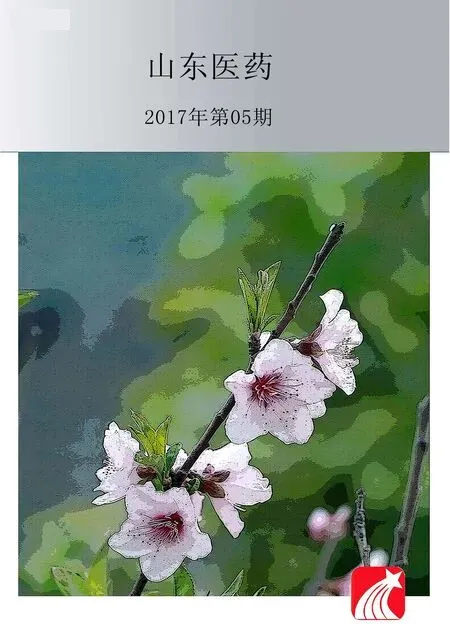树突状细胞与黑色素瘤细胞体外共培养体系对小鼠黑色素瘤形成的影响
郑云梅,和晨辰,王世忠,沈万秋,李海东
(1天津医科大学基础医学院,天津300070;2天津医科大学药学院)
·论著·
树突状细胞与黑色素瘤细胞体外共培养体系对小鼠黑色素瘤形成的影响
郑云梅1,和晨辰2,王世忠1,沈万秋2,李海东1
(1天津医科大学基础医学院,天津300070;2天津医科大学药学院)
目的 探讨树突状细胞(DC)与黑色素瘤细胞(B16)体外共培养后对小鼠黑色素瘤形成的影响。方法 提取小鼠骨髓细胞,分化DC,培养至第6天,将细胞分为4组,脂多糖(LPS)组、聚肌胞[Poly(IC)]组、Melan-A抗原肽(Melan-A)组分别加入DC佐剂LPS(终浓度100 ng/mL)、Poly(IC)(终浓度20 ng/mL)、Melan-A抗原肽(终浓度5 μmol/L)进行处理,未处理组未进行干预。采用流式细胞术检测DC成熟状态。B16细胞与培养第6天的DC共培养2 d。取C57BL/6J小鼠皮下注射B16细胞(8只),DC+B16细胞(8只),LPS(8只)、poly(IC)(8只)、Melan-A抗原肽激活(8只)的DC+B16细胞,接种B16细胞1周再接种DC+B16细胞(5只),对照组(3只)不接种细胞。于接种第14天取部分小鼠处死,取脾脏,镜下观察其组织形态;接种第28天测算肿瘤体积。结果 LPS组、Poly(IC)组、Melan-A组成熟DC多于未处理组。接种DC+B16细胞的小鼠未见肿瘤生长;接种第28天,与接种B16细胞的小鼠比较,接种LPS、poly(IC)、Melan-A抗原肽激活的DC+B16细胞及接种B16细胞1周再接种DC+B16细胞的小鼠肿瘤体积减小(P均<0.05)。与对照组比较,第14天接种DC+B16细胞小鼠脾脏滤泡结构无明显变化,而接种B16细胞及LPS、poly(IC)、Melan-A抗原肽激活的DC+B16细胞小鼠,脾脏滤泡结构增加。结论 DC与B16共培养可抑制小鼠黑色素瘤的形成。
黑色素瘤;树突状细胞;免疫治疗;小鼠
黑色素瘤恶性程度高,转移发生早,病死率高[1]。目前临床无有效根治方法。免疫治疗是继手术、放疗、化疗之后的治疗方式,在提高肿瘤治愈率、改善患者生活质量、延长生存期方面起重要作用[2]。树突状细胞(DC)是功能最强的抗原呈递细胞(APC),在免疫识别、免疫应答和免疫调控过程中发挥重要作用,是启动T细胞介导免疫反应的关键[3]。以DC为基础的免疫疗法已被应用于恶性肿瘤(如黑色素瘤)的治疗[4]。目前用于免疫治疗的靶向抗原主要是肿瘤特异性抗原或肿瘤相关抗原。将负载肿瘤抗原的DC输回体内,诱导产生有效的抗肿瘤免疫应答[5]。2014年9月~2016年10月,本研究建立体外黑色素瘤B16细胞与DC的共培养体系,探讨其对小鼠体内黑色素瘤生长的影响,为以DC为基础的肿瘤免疫疗法提供新的思路。
1 材料与方法
1.1 动物、试剂及仪器 6周龄雌性C57BL/6J小鼠(北京华阜康生物科技有限公司、中国医学科学院血液学研究所实验动物中心)55只。RPMI-1640培养基(北京索莱宝科技有限公司);胎牛血清和Melan-A抗原肽(上海生工生物工程股份有限公司);脂多糖(LPS)、聚肌胞[Poly(IC)](美国Sigma-Aldrich);粒细胞-巨噬细胞集落刺激因子(GM-CSF)、IL-4(美国PeproTech);PE标记的大鼠抗小鼠CD40、CD80、CD86单克隆抗体(美国BioLegend);小鼠黑色素瘤B16-F10(B16)细胞(美国ATCC细胞库);Accuri C6流式细胞仪(美国BD Biosciences)。
1.2 小鼠树突状细胞(DC)分化及培养 取6周龄雌性C57BL/6J小鼠7只。颈椎脱位法处死,取股骨和胫骨,以RPMI1640培养基将骨髓冲洗出,收集于离心管中,离心洗涤后获得骨髓细胞,计数。将细胞用含10%胎牛血清的RPMI1640完全培养基悬浮,加入(终浓度25 ng/mL)GM-CSF、(终浓度20 ng/mL)IL-4,于37 ℃、5% CO2培养箱中培养,每隔2 d换液,分化得DC。根据文献[6],将DC培养至第6天,随机分为4组:LPS组、Poly(IC)组、Melan-A抗原肽组及对照组,前3组分别加入LPS(终浓度100 ng/mL)、Poly(IC)(终浓度20 ng/mL)、Melan-A抗原肽(终浓度5 μmol/L),未处理组未干预,各设6个复孔。
1.3 成熟DC检测 采用流式细胞术。取各组DC,重悬于含1%牛血清白蛋白(BSA)的PBS缓冲液,加入荧光标记的抗CD40、CD80、CD86抗体,4 ℃孵育30 min,以PBS洗涤2次。采用流式细胞仪进行检测,用FlowJo软件对数据进行分析。CD80、CD86高表达的细胞为成熟DC,CD40高表达的细胞为活化的DC。
1.4 小鼠B16细胞培养 小鼠B16细胞培养于含10%胎牛血清的RPMI-1640培养基中。培养条件为37 ℃、5% CO2。共培养时B16细胞与分化至第6天的DC按照1∶4混合培养2 d。
1.5 小鼠黑色素瘤模型制备 取C57BL/6J小鼠进行接种。取对数生长期B16细胞或DC与B16细胞共培养细胞,重悬于无菌PBS缓冲液,调整B16细胞或共培养液中B16细胞为5×106/mL,皮下注射于小鼠后腿背侧;每只小鼠5×105个B16细胞。将小鼠分别接种B16细胞(8只),DC+B16细胞(8只),LPS(8只)、poly(IC)(8只)、Melan-A抗原肽激活(8只)的DC+B16细胞,接种B16细胞1周再接种DC+B16细胞(5只),对照组(3只)不接种细胞。除接种B16细胞1周再接种DC+B16细胞的小鼠其余各组分别取3只小鼠,于接种第14天后颈椎脱位法将其处死,取脾脏,固定于4%甲醛中,石蜡包埋、4 μm厚切片,组织切片经脱蜡水化后,苏木精-伊红染色,再脱水透明,中性树胶封片,显微镜下观察细胞和组织形态,拍照,放大100倍。除对照组外其余各组分别取5只小鼠,于接种第28天肉眼观察小鼠肿瘤生长情况,并用游标卡尺测量肿瘤长径、短径,计算肿瘤体积,体积=1/2×长径×短径2。

2 结果
2.1 DC成熟状态 LPS组、Poly(IC)组、Melan-A组处理2 d后,其表面抗原CD80、CD86表达高于未处理组。即LPS组、Poly(IC)组、Melan-A组成熟DC多于对照组。
2.2 小鼠黑色素瘤体积比较 接种DC+B16细胞的小鼠未见肿瘤生长。接种第28天,接种B16细胞的小鼠肿瘤体积为(7.100±0.604)cm3,接种LPS、poly(IC)、Melan-A抗原肽激活的DC+B16细胞的小鼠肿瘤体积分别为(2.640±0.601)、(4.440±0.384)、(4.440±0.373)cm3,与接种B16细胞的小鼠比较肿瘤体积减小(P均<0.05)。接种B16细胞1周再接种DC+B16细胞的小鼠肿瘤体积(3.375±0.800)cm3,与接种B16细胞的小鼠比较肿瘤体积减小(P<0.05)。
2.3 荷瘤小鼠脾脏组织形态变化 与对照组比较,接种第14天接种DC+B16细胞小鼠脾脏滤泡结构无明显变化,而接种B16细胞及LPS、poly(IC)、Melan-A抗原肽激活的DC+B16细胞小鼠,脾脏滤泡结构增加。
3 讨论
DC是机体中功能最强的专职APC,它能高效摄取、加工处理和递呈抗原,未成熟DC具有较强的迁移和內吞抗原能力,成熟DC能有效激活初始型T淋巴细胞,处于启动、调控、维持免疫应答的中心环节,在机体的抗肿瘤免疫中发挥重要作用[3]。
将黑色素瘤细胞B16接种到小鼠体内,会迅速生长形成肿瘤。本研究发现,DC和B16细胞共培养后再接种到C57小鼠体内,并不会形成肉眼可见的肿瘤。在体外共培养过程中,B16细胞碎片和表面抗原会被未成熟DC吞噬,在细胞内加工处理并由主要组织相容性复合体递呈在细胞表面。接种到体内后,这些DC将可能激活T淋巴细胞,对肿瘤细胞产生抑制和杀伤作用。另一方面,在体外共培养过程中加入DC的激活因子可能会对DC内吞抗原以及随后其在体内的抗肿瘤功能产生抑制作用。有研究认为,佐剂的使用可能会诱导DC耐受性的形成[7],这与我们的研究结果一致。
DC免疫耐受性产生的机制是抗肿瘤免疫研究的一个重要方面。有研究结果显示,低剂量的LPS刺激DC,可以使小鼠对肿瘤产生一定的免疫作用;但使用高剂量的LPS或多次用LPS刺激DC,则会使小鼠体内的吲哚胺2,3-双加氧酶水平上调,而这种物质的高表达会使小鼠产生肿瘤的免疫耐受[8]。Poly(IC)对小鼠黑色素瘤的作用也正在深入研究中[9]。DC是联系机体天然免疫反应和适应性免疫反应的关键细胞。DC的免疫特异性通过激活T淋巴细胞来实现。DC和被激活的T淋巴细胞释放一系列细胞因子如IL-2等,进一步促进T淋巴细胞的增殖、活化。T淋巴细胞可转化为效应T细胞和记忆T细胞。前者直接对肿瘤细胞产生杀伤作用,并且CD4+T细胞可以刺激B淋巴细胞的增殖、活化,促使B淋巴细胞产生肿瘤特异性的抗体;后者可使得机体保持较为持久的抗肿瘤免疫能力[10]。
小鼠接种B16细胞后,脾脏结构发生了显著变化,其滤泡结构增多,提示其淋巴细胞增殖和活化;小鼠体内产生了一定的免疫反应,但是不能够有效控制肿瘤的生长。由于实验设计和条件所限,未能观察接种B16细胞1周再接种DC+B16细胞的小鼠脾脏变化。与经LPS、Poly(IC)和Melan-A抗原肽处理的共培养细胞比较,单纯将DC和B16细胞共培养对肿瘤的抑制作用较好。有研究表明,单纯采用一种黑色素瘤抗原进行抗肿瘤免疫治疗的作用效果有限,并且不能有效抑制恶性肿瘤的快速生长[11]。将黑色素瘤抗原与单克隆抗体[11]或者IL-2[12]联合使用会有较好的治疗肿瘤的效果。
[1] 黑色素瘤专家委员会.中国黑色素瘤诊治指南:2015版[M].北京:人民卫生出版社,2015:1.
[2] 孟冉冉,张跃伟,赵广生,等.树突状细胞肿瘤疫苗抗肿瘤研究进展[J].中华肿瘤防治杂志,2012,19(20):1597-1600.
[3] Palucka K, Banchereau J. Cancer immunotherapy via dendritic cells[J]. Nat Rev Cancer, 2012,12(4):265-277.
[4] Dashti A, Ebrahimi M, Hadjati J, et al. Dendritic cell based immunotherapy using tumor stem cells mediates potent antitumor immune responses[J]. Cancer Lett, 2016,374(1):175-185.
[5] 司春枫,鲁美钰,周玲,等.肿瘤疫苗免疫策略研究进展[J].现代肿瘤医学,2016,24(15):2478-2482.
[6] Inaba K, Inaba M, Romani N, et al. Generation of large numbers of dendritic cells from mouse bone marrow cultures supplemented with granulocyte/macrophage colony-stimulating factor[J]. J Exp Med, 1992,176(6):1693-1702.
[7] Flacher V, Tripp CH, Mairhofer DG, et al. Murine Langerin+dermal dendritic cells prime CD8+T cells while Langerhans cells induce cross-tolerance[J]. EMBO Mol Med, 2014,6(9):1191-1204.
[8] Fallarino F, Pallotta MT, Matino D, et al. LPS-conditioned dendritic cells confer endotoxin tolerance contingent on tryptophan catabolism[J]. Immunobiology, 2015,220(2):315-321.
[9] Shime H, Kojima A, Maruyama A, et al. Myeloid-derived suppressor cells confer tumor-suppressive functions on natural killer cells via polyinosinic:polycytidylic acid treatment in mouse tumor models[J]. J Innate Immun, 2014,6(3):293-305.
[10] Sevko A, Kremer V, Falk C, et al. Application of paclitaxel in low non-cytotoxic doses supports vaccination with melanoma antigens in normal mice[J]. J Immunotoxicol, 2012,9(3):275-281.
[11] Ly LV, Sluijter M, van der Burg SH, et al. Effective cooperation of monoclonal antibody and peptide vaccine for the treatment of mouse melanoma[J]. J Immunol, 2013,190(1):489-496.
[12] Schwartzentruber DJ, Lawson DH, Richards JM, et al. gp100 peptide vaccine and interleukin-2 in patients with advanced melanoma[J]. N Engl J Med, 2011,364(22):2119-2127.
Effect of co-culturing dendritic cells with melanoma cells on formation of melanoma in mice
ZHENGYunmei1,HEChenchen,WANGShizhong,SHENWanqiu,LIHaidong
(1SchoolofBasicMedicalSciences,TianjinMedicalUniversity,Tianjin300070,China)
Objective To investigate the effect of co-culturing dendritic cells (DC) with melanoma cells (B16) on growth of melanoma in mice.Methods We extracted the bone marrow cells. Mouse DC were cultured for 6 days and then were divided into 4 groups: lipopolysaccharide (LPS) group, Poly (IC) group, and Melan-A group and the control group. Cells in the LPS group, Poly (IC) group, Melan-A group were incubated with LPS (LPS with final concentration of 100 ng/mL), poly-inosinic-cytidylic acid [Poly(IC) with final concentration of 20 ng/mL] and Melan-A peptide (with final concentration of 5 μmol/L), respectively. The control group was not treated. Flow cytometry was used to study the maturation and activation state of DC. B16-F10 (B16) melanoma cells were co-cultured with DC for 2 days and then were used for inoculation of mice. For melanoma model, C57BL/6J mice were inoculated subcutaneously. Some mice were killed at 14 days after inoculation and their spleens were taken to study the structural changes by histochemistry. Tumor size was measured at 28 days after inoculation.Results More mature DC were produced after LPS, Poly(IC) or Melan-A peptide treatment as compared with that of the control group (P<0.05). There was no tumor growth after DC+B16 cell inoculation. Compared with the mice inoculated with B16 cells only, the tumor volume was smaller in the mice inoculated with LPS, Poly(IC) or Melan-A peptide-activated DC+B16 cells or the mice inoculated with B16 cells one week later followed by another inoculation of DC+B16 cells (allP<0.05). Compared with the control group, there was no structural change of the spleen follicles in the mice inoculated with DC+B16, but the number of spleen follicles was increased in the mice inoculated with B16 or with LPS, Poly (IC), or Melan-A peptide-activated DC+B16 cells.Conclusion DC co-cultured with B16 can inhibit the growth of melanoma in mice.
melanoma; dendritic cells; immunotherapy; mice
国家自然科学基金资助项目(21373151)。
郑云梅(1990-),女,在读硕士,主要研究方向为树突状细胞在肿瘤免疫治疗中的作用。E-mail:1573237770@qq.com
李海东(1971-),男,博士,教授,主要研究方向为肿瘤免疫。E-mail:yxswhx@qq.com
10.3969/j.issn.1002-266X.2017.05.001
R739.5
A
1002-266X(2017)05-0001-03
2016-11-02)

